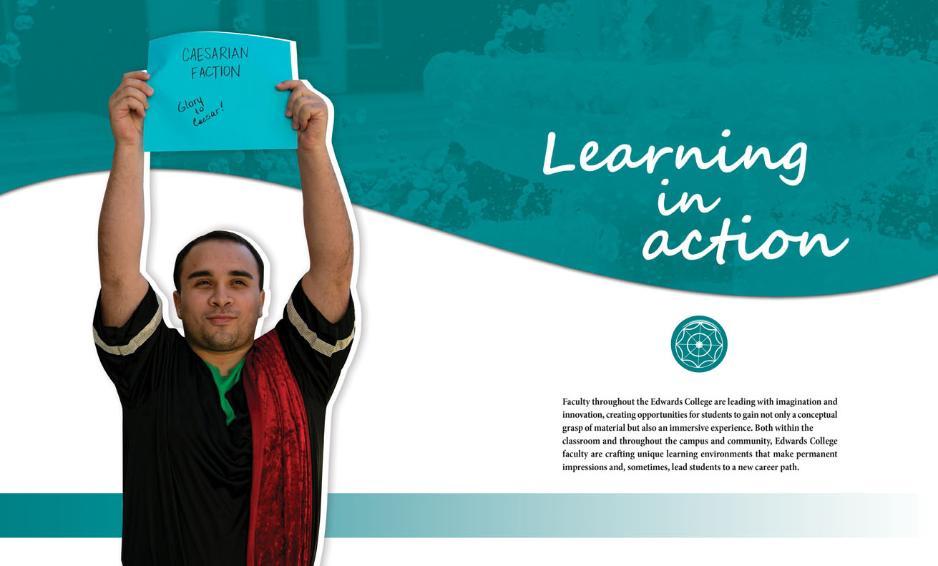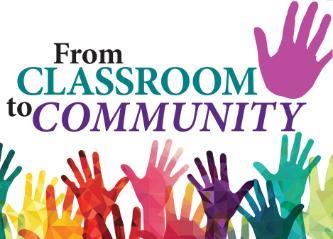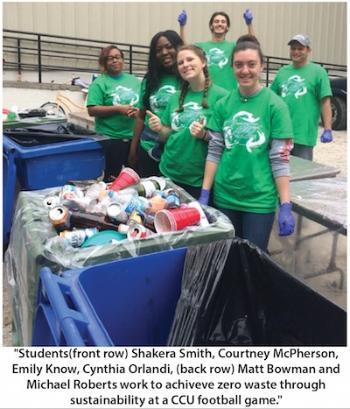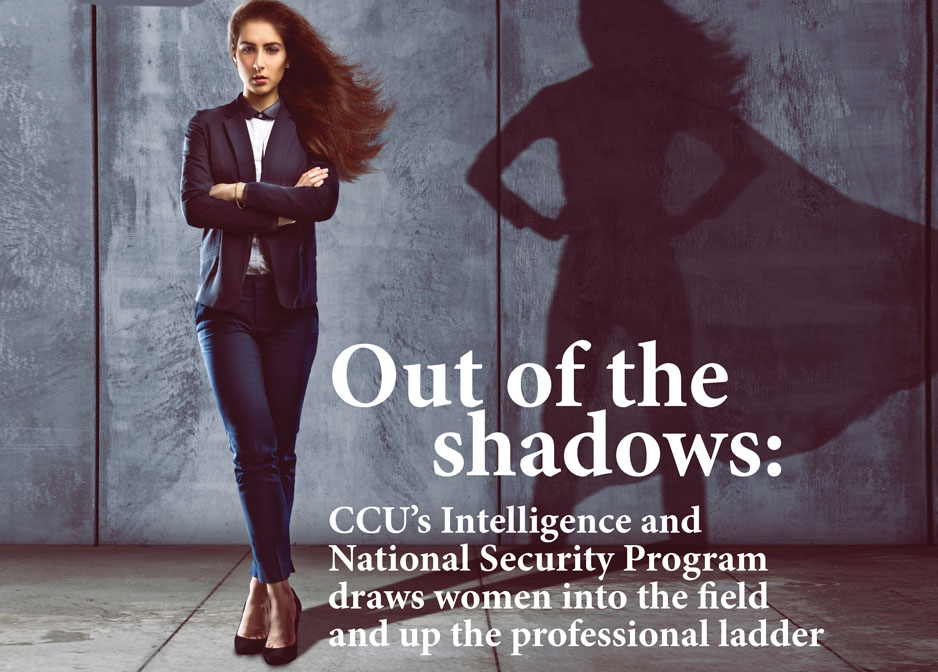Learning in Action

Getting in Your Head
Reacting to the Past role-playing game allows students to gain an insider’s perspective on historical moments.
"Assassinations are possible.”
Elizabeth Baltes mutters the prediction for her class as Roman senators file in, clad in togas and laurel wreaths, each considering strategically where to sit in order to maximize his persuasive contribution to the hour’s proceedings. The date is 44 BCE, and the Senate is about to hold debate on a course of action following Julius Caesar’s recent and violent death.
Rather than watching a video or taking a test on the nature of Roman civilization, students in Baltes’ art history course, Roman Art and Architecture, are experiencing the tensions and interpersonal dynamics of the time period for themselves. Using a pedagogical curriculum called Reacting to the Past, students engage in elaborate and immersive role playing, each adopting the identity of a player in a specific, significant historical moment. The game lasts about five weeks out of the semester and involves a complex framework of historical characters who attempt to persuade one another into adopting a particular set of beliefs and acting in a manner that will, essentially, determine the course of history.
In this classroom, Mark Antony, Tiberius Nero and other Roman senators alternate giving impassioned speeches about whether, as a great leader, Caesar’s memory should be honored with a public parade and burial or whether, as a criminal, his body should be thrown in the Tiber river.
“We don’t have to obey a dead man, and we certainly don’t have to obey a dead criminal,” declares Tiberius Nero, a.k.a. art history major Bob Sherman.
Students deliver the oratory, informed by readings from primary texts, reflective writings and previous class discussions, in spontaneous and theatrical performances. Other students, in the roles of senate members, listen, take notes and quietly confer with one another as they consider the merits of each argument.
Sherman explains that the game works effectively to motivate students and encourage active participation.
“It’s the dynamism that makes a big difference,” Sherman says. “Students who were so shy in class, wouldn’t raise their hand or speak very often, were up there talking, taking part, they were sticking to their issues and arguing. It was the hands-on component that was really helpful – it made you understand how the senate works, how voting works, and why logic usually goes out the window when it comes to people who have competing motivations.”
Created in the early 1990s by Mark C. Carnes, professor of history at Barnard College, Reacting to the Past currently offers 13 games organized within textbook instructor manuals, as well as dozens of games in development. Titles include “Rousseau, Burke, and Revolution in France, 1791”; “Defining a Nation: India on the Eve of Independence, 1945”; and “Charles Darwin, the Copley Medal and the Rise of Naturalism, 1861-64.” Faculty at hundreds of colleges and universities across the country have adopted Reacting to the Past games since dissemination began in 2001, and the pedagogy has been reviewed and covered in InsideHigherED, the Chronicle of Higher Education and New Republic.
In Shari Orisich’s history class, Women and Power in the Americas, factions are gathering. It’s 1915 in Greenwich Village, New York, and suffragists and bohemians are debating which element of the women’s movement should take precedence in their political influence. As historic figures Margaret Sanger, Emma Goldman and Charlotte Perkins Gilman take turns presenting their perspectives, they compete to earn personal influence points from undecided parties. Each student works from a character role sheet, but how the student embodies that character allows for creativity and freedom.
“These games aren’t simulations or re-enactments,” says Orisich; “Students in roles are really reacting to the issues of the time, so things can go very differently than they did in history. The character could get arrested, or assassinated, or the government could shut down their operation, but it doesn’t always happen with historical accuracy. The students become so invested in the point of view of their character that they put themselves in a historical mindset around that topic, being who they are. I can’t say I achieve that if I’m lecturing all the time.”
Another benefit of the game, Orisich said, is that students experience perspectives different from their own from the inside out.
“These games ultimately strive to build empathy with people living in the past who might have been very different from themselves. I put men in women’s characters and vice versa, to get them to walk in the shoes of someone else,” said Orisich. Christina Melchoirre, a student/senator in the Roman forum, agrees that embodying a character provides for a wholly different kind of learning than the traditional model.
“I love kinesthetic learning and actually having hands-on experiences, and so I thought it was a great way to learn it,” said Melchoirre. “We’re not just sitting and writing it down; we’re actually learning through experiencing the past.”
From Classroom to Community
In many college courses, the extent of the lesson takes place in the classroom. In Deborah Breede’s COMM 345 Communication Activism course, however, the lesson becomes a study and a practice. Whether it’s running food and clothing drives for local grade schools, performing cleanups in areas of waste disposal or simply raising awareness of cultural issues, many students have been making strides toward building a better community.
Established in 2013, the Communication Activism course was an opportunity for Breede to build upon her doctoral studies at the University of South Florida and apply knowledge of activism gained within the classroom to first-hand action outside of it.
“I was noticing that more and more schools were getting social justice activism courses,” Breede said, “and I thought to myself, ‘I’m going to put this course together where students have to use the principles of communication activism to make positive change within their communities’ – more specifically for CCU, the campus community and surrounding areas.”

Since then, COMM 345 has become one of the most popular courses in the communication major, garnering attention from students across disciplines. Activism events have included partnerships with Wounded Warriors, the North Myrtle Beach Women’s Club and local groups that combat human trafficking.
In past semesters, students focused on and performed a single activism project; in Fall 2017, however, their diverse interests led to two separate projects: one on educational activism and the other on sustainability.
“Some students volunteered for the Teal Youth Day” hosted by CCU’s Dalton and Linda Floyd Family Mentoring Program, said Breede. “Their focus was in mentoring students in public schools while also leading a donation drive to provide food and clothing for the elementary and middle schools in the area. The other group worked on sustainability projects, which led to them working a football game in which they tried to achieve zero waste through sustainability. I was thrilled to see the
students being able to successfully accomplish multiple projects in one semester across different modes of activism.”
Cynthia Orlandi, a senior communication major, assisted with the Zero Waste Football Game. In partnership with Jeremy Monday, sustainability coordinator for CCU, their objective was to divert 90 percent of the trash generated at the game from a local landfill.
“Our motto from Mr. Monday was that ‘zero waste is an effort,’” said Orlandi. “The stadium cleanup involved collecting recyclables and compostables, dumping recyclables, bagging compostables, taking them to a storage location and putting new bags throughout the stadium. I learned so much working that event. I recycle everything now and even make my roommates do it, too.” Orlandi reported the group came very close to reaching its goal, achieving 87.44 percent diversion of waste.
COMM 345 is broken down into two portions. One is an examination of various outlets and topics of social activism throughout contemporary culture; subjects include poverty, social justice, human trafficking and racial inequality. The second half of the class involves applying the knowledge learned in the classroom to “the field” as students propose, generate and enact their own activism projects. The work happens on and off campus, with many projects occurring in conjunction with other community activism groups.
“I tell my students early on that the class is very much a leap of faith,” said Breede. “I can’t tell them what the second half of the semester is going to look like; they’re going to tell me, which I see as the beauty of this course. In many ways, I become the student, and they become the teachers.”
 “Because of the service-based content of the class,” said Hunt, “students not only leave with real-world experience, but often content for their portfolios and resumes as well. Because they are doing real work in the community, this work is relevant in the job market later on. This is more valuable than any letter grade could ever be.”
“Because of the service-based content of the class,” said Hunt, “students not only leave with real-world experience, but often content for their portfolios and resumes as well. Because they are doing real work in the community, this work is relevant in the job market later on. This is more valuable than any letter grade could ever be.”
In five years, many students have completed the course and gained tangible benefits and a long-term commitment to activism. CCU alumna Katherine Hunt, outreach coordinator for the Museum of Coastal Carolina and Ingram Planetarium, is now a visiting speaker for the course, providing current students insight into the ways the communication curriculum has assisted her.
For Breede, the success of the course has exceeded her greatest hopes. Through her methods of experiential learning, COMM 345 has provided a steady and consistent home for students seeking to make positive changes in their college community as well as the areas surrounding CCU. When asked if she’d like to make anything clear to future students, her answer was simple.
“Anyone is welcome to take the course!” said Breede. “If they’d like to make a difference in this community, who am I to refuse them?”

Out of the Shadows
CCU's Intelligence and National Security Program draws women into the field and up the professional ladder.
We all like to believe that education allows people to become anything they want to be. However, the reality is that some students, even at the university level, hear and see the opposite truth: All people do not have full and equal access to all professions. Joseph Fitsanakis, associate professor in CCU’s Department of Politics, found such a reality when he joined CCU’s intelligence and national security studies (intel) program in 2015.
“I noticed very quickly that we didn’t have many women in the program, which is an issue; it’s a problem for the intelligence community as a whole,” said Fitsanakis, who specializes in international espionage and has written extensively on intelligence policy and practice.
Fitsanakis consulted with Holley Tankersley, then-chair of the Department of Politics, and the pair established the Women in National Security (WINS) club, which began in November 2016 with an inaugural group of 15 students.
“We devised a plan on how to fix the problem,” said Fitsanakis. The WINS club was designed to “act as a confidence-building group and encourage more women to, A.) stay with the program and, B.) apply for more positions in the intelligence community. It’s the first group of its kind in the nation.”
Senior Jenny Thorpe, intel major and WINS founding member, said the dearth of women in the program is noticeable yet understandable.
“When you hear ‘intel and national security,’ you think, ‘Oh, FBI and CIA.’ You think guys when you think spies – that’s the first thing you think of.”
WINS grew steadily over its first year to nearly 50 members and held events such as a panel discussion during Women’s History Month 2017 about females in the CIA.
In March 2018, the group achieved its first groundbreaking feat with a two-day conference held on the CCU campus – fully organized and implemented by students – that drew 45 nationally renowned speakers in the national security field and more than 200 attendees.
Under a grant from CCU’s Quality Enhancement Plan committee, Fitsanakis along with Ina Seethaler, assistant professor and director of Women’s and Gender Studies, and Kaitlin Sidorsky, assistant professor in the Department of Politics, co-taught a course titled Women in Intelligence and National Security in Spring 2018, the objective of which was to organize the conference. The event also garnered support from the Edwards College, University College and Women in Philanthropy and Leadership (WIPL) for Coastal Carolina University, under the guidance of Executive Director and CCU First Lady Terri DeCenzo.
Agents, officers and analysts from the FBI, CIA, National Security Agency, Drug Enforcement Administration and Air Force delivered lectures, workshops and panel discussions at the conference on topics including preparing for a career, networking, women working undercover, and overcoming challenges in intelligence.
Martha Peterson, a retired CIA officer and the first U.S. female intelligence officer stationed in communist Russia in the 1970s, was the keynote speaker for the conference. Her story is the subject of a memoir titled Widow Spy (2012) as well as the premiere episode of CNN’s Declassified series (2016). In her lecture, Peterson detailed her story as well as factors that allowed her to serve so effectively as a spy.
“One of the things she mentioned is that the Russians never suspected her of being a case officer because she was a woman,” said Fitsanakis. “They didn’t think that the CIA would actually have women do that, so she was able to operate very freely.”
Following the presentation, Peterson noted the professionalism of students hosting the conference and the preparation and knowledge of students in the audience.





